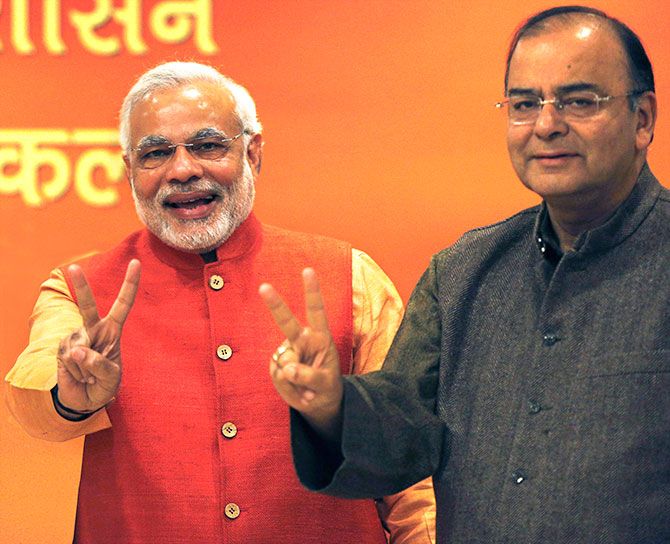Reduce the government stake in public sector banks to 33 per cent, recommends A K Bhattacharya

IMAGE: Prime Minister Narendra D Modi and Finance Minister Arun Jaitley. Photograph: Ahmad Masood/Reuters
The department of financial services, a wing of the Union finance ministry, has a headcount of about 1,600 employees.
On paper, this number may look impressive. But the overall staff strength of any department at the Centre, however, does not truly reflect its management or supervision capacity.
What matters more is the composition and quality of the staff. The department of financial services is no exception.
A large portion of the 1,600 employees on the department's roll consists of junior-level officers, clerks, and support staff.
The top team, if you count officials with the rank of joint secretary and above, has only eight persons -- six joint secretaries, one additional secretary, and a secretary in charge of the department.
If you assume that officials below the rank of joint secretary also contribute to the top management strength, then the list could get longer with one deputy director general, two economic advisors, seven directors, six deputy secretaries, two joint directors, 17 under secretaries, two deputy directors, and 20 section officers.
In all, the top team at the department of financial services including those above section officers would not be more than 65.
Now, consider the workload of these employees.
Apart from the administration of a host of financial sector laws pertaining to the banking and insurance sectors, these officials are entrusted with the responsibility of overseeing all matters pertaining to public sector as well as private sector banks, the Reserve Bank of India, cooperative banking, financial institutions, and the Export-Import Bank of India.
In addition, they are also expected to oversee policy relating to life insurance, general insurance, administration of the Insurance Act, and the General Insurance Business (Nationalisation) Act.
It is doubtful if, after taking care of all these responsibilities, the top team at the department has much time left specifically for overseeing the operations of about 21 public sector banks and seven insurance companies, in which the government has a majority shareholding.
Nor does it appear that the team has the capacity or skillset to protect and promote the interests of the government as a majority shareholder in these 28 State-owned financial sector entities.
What hope can then the Union finance ministry have of its department of financial services ensuring that its nationalised banks and insurance companies follow prudent business practices and governance norms?
Not just in terms of the quality of manpower, but even in terms of the headcount of persons responsible for overseeing these State-owned financial sector entities, the department of financial services is simply unable to adequately look after the interests of the government as the majority shareholder in these entities.
What has happened to the Punjab National Bank is a case of how its managers have flouted basic norms of doing business.
Of course, regulation has to get better and the RBI must be more vigilant. But if the department of financial services had effectively monitored the business practices of the bank through its directors on its board, the problem could have surfaced much earlier and the damage could have been less.
Neither was there adequate supervision at the level of the bank nor did the department of financial services ensure that the bank managers were subjected to rigorous compliance norms.
What can the government do in the current situation?
The department of financial supervision is inadequately staffed or trained to monitor the functioning of the public sector banks.
At the same time, the nationalised banks, after having a good run during the 1990s, have gradually lost out to private sector banks in the last several years.
Their share in credit has declined from around 72 per cent about five years ago to just about 66 per cent now.
Nor have the public sector banks been able to attract talent from the private sector and recent efforts to appoint private sector managers to head them have made slow progress.
One area of strength for the public sector banks was the popular support they used to enjoy. Their customers were usually happy with their performance.
Recent customer feedback surveys monitored by the government and the regulator show that the popular support they used to enjoy in the past is on the wane.
Given the capacity constraints in the department of financial services to oversee the state-owned financial sector entities and the inability of public sector banks to attract talent from the private sector, the government has no option other than planning a time table for gradual divestment of its stake in these banks.
The ultimate goal to be achieved over the next few years should be to bring down government equity in these banks below 49 per cent and allow a strategic investor with a majority to run them.
An idea that Yashwant Sinha had mooted as finance minister in 2000 is worth revisiting: Reduce the government stake in public sector banks to 33 per cent.









